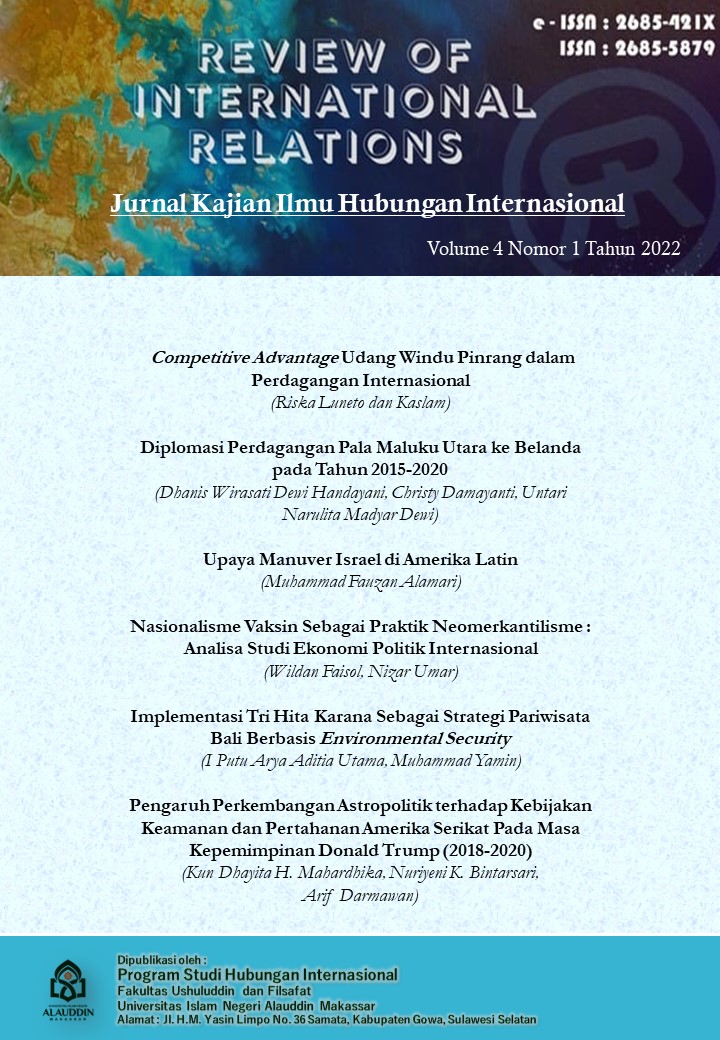IMPLEMENTASI TRI HITA KARANA SEBAGAI STRATEGI PARIWISATA BALI BERBASIS ENVIRONMENTAL SECURITY
Abstract
As a tourism area that has been worldwide, Bali certainly has various problems it faces. The rapid development of tourism in Bali has resulted in many impacts resulting from this industry. The impacts resulting from the tourism industry not only provide benefits for Bali, but also provide considerable losses. One of the aspects that suffer the most from the development of tourism is the environmental aspect. As a multidimensional industry, tourism will have many significant impacts on the environment, starting from the construction of facilities, the use of transportation equipment, and the operation of the tourism industry. Therefore, Bali must prevent any damage that may be caused by the tourism industry because Bali also offers natural beauty as a tourism attraction. The ideal strategy that can be applied by Bali is to implement the Tri Hita Karana concept which consists of parayangan, pawongan, and palemahan. The implementation of the Parahyangan can be done by protecting the environment around the temple which is also a tourist destination. The implementation of pawongan is carried out by collective action between the community, government, and tourism actors to jointly realize tourism based on environmental security. The application of palemahan can be done starting from small actions, namely not littering and being able to protect the environment properly. The application of the three elements that compose Tri Hita Karana will be able to create Bali tourism based on environmental security and be able to overcome various problems that threaten the environment.
Downloads
References
Agung, D. (2002). Lestarikan Bali Dengan Tri Hita Karana. Hindu-Indonesia.
Arifin, Z. (2017). Bali, Penyumbang Devisa Terbesar di Sektor Pariwisata. Tribun News. https://www.tribunnews.com/nasional/2017/08/10/bali-penyumbang-devisa-terbesar-di-sektor-pariwisata
Peraturan Daerah Propinsi Daerah Tingkat I Bali No. 3 Tahun 1991 tentang Pariwisata Budaya, (1991).
Borghesi. (1999). The Environmental Kuznets Curve: A Survey Literature. European University Institute, 85(1).
BPS. (2018). Jumlah Devisa Sektor Pariwisata. https://bps.go.id/indikator/indikator/view_data/0000/data/1160/sdgs_8/1
BPS Bali. (2021). Jumlah Wisatawan Asing ke Indonesia dan Bali, 1996-2020.
Butler, R. (1999). Sustainable Tourism: A State Of The Art Review. Tourism Geographies, 1(1).
Buzan, B. (2009). The Evolution of International Security Studies. Cambridge University Press.
Environmental Security: A Case Study of Climate Change., (2018).
Cooper. (1995). Business Research Methods. Irwin.
Darmawi, A. (2013). The Composting Of Casuarina Equisetifolia L As A Solution To Create The Zero Waste Area In Pantai Baru Distric Bantul. Gadjah Mada Univerity.
Darmawi, A. (2017). Potential of Waste Drinking In New Tourism Object In Regency Bantul Yogyakarta. Jurnal Penelitian Teknologi Industri, 1(1). file:///C:/Users/Microsoft/Links/2907-11349-1-PB.pdf
Dibya, K. (2018). Pengembangan Pariwisata Berbasis Tri Hita Karana (Studi Pengembangan Pariwisata Berkelanjutan di Bali). Maha Wdiya Duta, 2(1).
Dixon, T. (1999). Environment, Security, and Violence. Princenton University Press.
Ernawati, M. (2010). Tingkat Kesiapan Desa Tihingan-Klungkung Sebagai. Jurnal Analisis Pariwisata, 10(1).
Harmini. (2014). Penerapan Prinsip Tri Hita Karana dalam Pengelolaan Vila di Kelurahan Seminyak Kuta. Jurnal Media Bina Ilmiah, 8(7).
Hertel. (1989). Modeling Pollution from Traffic in a Street Canyon: Evaluation of Data and Model Development.
JICA. (2005). Japan International Cooperation Agency Annual Report 2005.
Kemenparekraf. (2012). Kode Etik Kepariwisataan Dunia. Kemenag.Go.Id.
Kemenparekraf. (2020). Laporan Kinerja Kementerian Pariwisata dan Ekonomi Kreatif Tahun 2020.
Khairunnisa, S. (2021). Bali Jadi Destinasi Paling Diminati di Indonesia Awal Tahun 2021. Travel.Kompas.Com. https://travel.kompas.com/read/2021/03/11/123624927/bali-jadi-destinasi-paling-diminati-di-indonesia-awal-tahun-2021?page=all
Kusuma dkk. (2016). Aktivitas Wisata Spiritual Dan Motivasi Berwisata di Daya Tarik Wisata Tanah Lot Kabupaten Tabanan. Jurnal Destinasi Wisata, 4(2).
Myers. (1986). The Environmental Dimension to Security Issues. The Enironmentalist, 6.
Parma, G. (2010). Pengamalan Konsep Tri Hita Karana di Hotel: Sebuah Studi Kasus Pengambangan Hotel Berwawasan Budaya Di Matahari Beach. Jurnal Media Bina Ilmiah Lembaga Pengembangan Sumber Daya Insani (LPSDI), 4(2).
PHDI. (1983). Himpunan Keputusan Seminar Kesatuan Tafsir Terhadap Aspek-Aspek Agama Hindu I-IX.
Rahmawati, P. I. (2003). Pengantar Pariwisata. IKIP Negeri Singaraja.
Richardson & Fluker. (2004). Understanding and Managing Tourism. Pearson Education.
Rosidin, I. (2021). 80 Ton Sampah Terdampar di Pantai Kuta hingga Seminyak. Regional.Kompas.Com.
Soedomo. (1983). Pengukuran Emisi Pencemaran Udara Bersumber dari Lalu lintas Perkotaan, Inventaris, dan Identifikasi.
Spillane, J. (1994). Pariwisata Indonesia, Siasat Ekonomi dan Rekayasa Kebudayaan. Gramedia Jakarta.
Sulistyawan. (2008). Ajeg Bali untuk Pariwisata Berwawasan Lingkungan. Balebengong.Id.
Wall, G. (1998). Tourism: economic, physical, and social impacts. Longman.
Wastika, D. (2007). Penerapan Konsep Tri Hita Karana Dalam Perencanaan Perumahan di Bali. Jurnal Agama Hindu, 1.
WTTC. (2011). Travel & Tourism’s Economic Impact. Wttc.Org. https://issuu.com/aibmarketing/docs/wttc_tourism2011
Yuliandini, M. (2021). Tri Hita Karana dan Keharmonisan Hidup Bersama. Kemenag.Go.Id.
Copyright (c) 2022 I Putu Arya Aditia Utama, Muhammad Yamin

This work is licensed under a Creative Commons Attribution-ShareAlike 4.0 International License.










